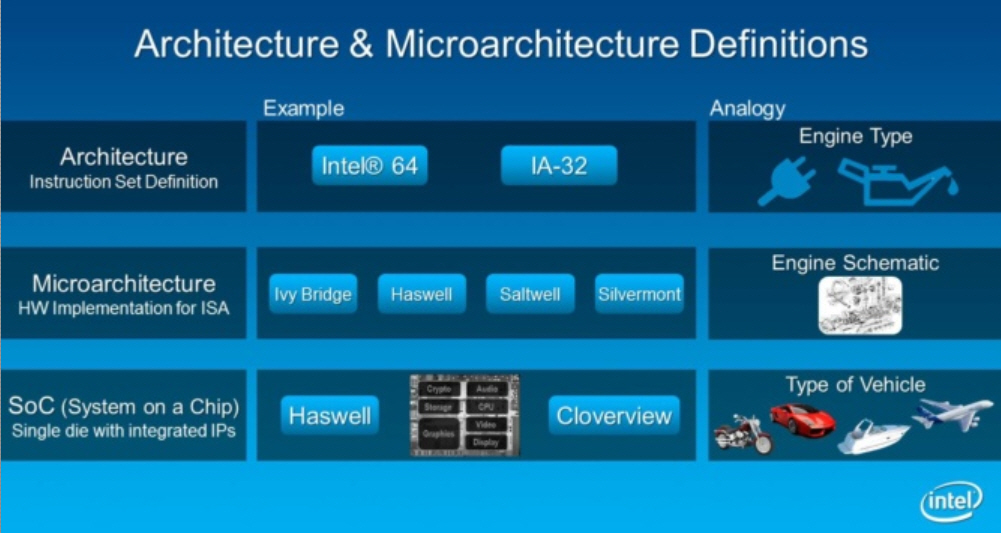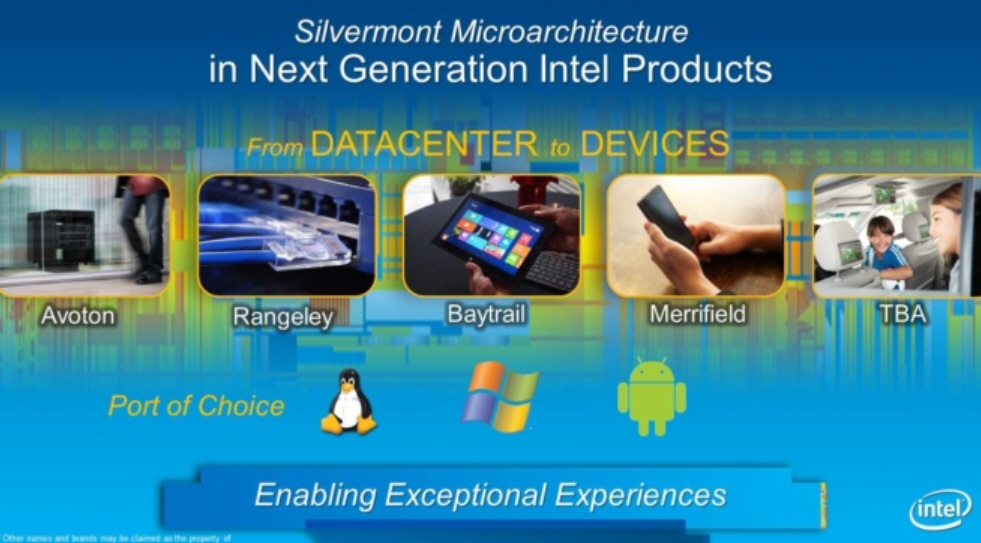Earlier this week, we took a look at where Intel it going with its next-generation integrated SoCs. Specifically we took a look at Intel's new Haswell architecture and what it means for Intel's future. Also this week, Intel announced its next generation micro architecture - Silvermont, which includes the next generation of its Atom microprocessor architecture that targets mobile products, and which will manifest itself as one of various Silvermont micro architecture iterations. As does Haswell, Silvermont will take advantage of Intel's 22 nanometer Tri-Gate SoC processes, and is slated to deliver significant increases in performance and energy efficiency - for the same reasons that Haswell, as we described in the article noted, will accomplish the same.
Intel claims that Silvermont will deliver three times more peak performance or the same performance utilizing essentially five times lower power consumption as compared to current generation Atom processor cores. This combination of high performance at greatly reduced power levels has great industry significance, and is central to Silvermont, which will serve as the foundation for an entire range of 22nm products that will be suitable for use in tablets, smartphones, micro-servers, network infrastructure, storage and other market segments, including entry-level laptops and in-vehicle infotainment. All of these product segments will begin to see delivery of actual products later in 2013.
Intel's Silvermont micro architecture was designed and co-optimized with Intel's 22nm SoC process using revolutionary 3D Tri-gate transistors. By taking advantage of this technology Intel can now provide significant improvements in both performance and energy efficiency. This last has long been a challenge - typically greater performance means higher levels of energy use, as well as higher levels of heat generation. The 22 nm processes change this dynamic and allow Intel to deliver greater truly non-trivial improvements in power management without sacrificing non-trivial improvements in performance - an ideal scenario for many applications, but especially for the mobile market.
Dadi Perlmutter, Intel executive vice president and chief product officer makes it clear that Intel believes, "Silvermont is a leap forward and an entirely new technology foundation for the future that will address a broad range of products and market segments. Early sampling of our 22nm SoCs, including 'Bay Trail' and 'Avoton' is already garnering positive feedback from our customers. Going forward we will accelerate future generations of this low-power micro architecture on a yearly cadence."
OK, "cadence" is perhaps an odd word to use here - "cycle" may be more to your liking, but in any case it is clear Intel is greatly stepping up its processor delivery game. Resting on past laurels will no longer work. Mobility and the mobile competitors Intel now has - such as ARM, nVidia and Qualcomm, leave the company playing catch up, but that is something Intel intends to be only a short term scenario.
The following diagram from Intel shows how Silvermont relates to Haswell:

Highlights for the Silvermont micro architecture include the following:
- A new multi-core and system fabric architecture scalable up to eight cores and enabling greater performance for higher bandwidth, lower latency and more efficient out-of-order support for a more balanced and responsive system.
- New IA instructions and technologies bringing enhanced performance, virtualization and security management capabilities to support a wide range of products. These instructions build on Intel's existing support for 64-bit and the breadth of the IA software installed base.
- Enhanced power management capabilities including a new intelligent burst technology, low- power C states and a wider dynamic range of operation taking advantage of Intel's 3 D transistors. Intel Burst Technology 2.0 support for single- and multi-core offers great responsiveness scaled for power. (In other words, much lower power consumption!)
- A new out-of-order execution engine enables best-in-class, single-threaded performance efficiency.
Belli Kuttanna, Intel fellow and chief architect, notes, "Through our design and process technology co-optimization we exceeded our goals for Silvermont. By taking advantage of our strengths in micro architecture development and leading-edge process technology, we delivered a technology package that enables significantly improved performance and power efficiency – all while delivering higher frequencies. We're proud of this accomplishment and believe that Silvermont will offer a strong and flexible foundation for a range of new, low-power Intel SoCs."
One Expanding Architecture, Many Applications
During a call that Intel held for the introduction of Silvermont, the company made it clear that the architecture has been designed to be expandable in a number of ways. And yes, there were the usual collections of code names thrown in as well which we've listed below. The following chart provides a summary view:

It is worth noting, as the chart suggests, that Intel intends for these architectures to be operating system independent. Silvermont itself serves as the foundation. Being built off of this foundation, as the chart shows, are the following:
Bay Trail quad-core SoC: Scheduled for holiday 2013 tablets, Bay Trail will more than double the compute performance capability of Intel's current-generation tablet offering. Due to the flexibility of Silvermont, variants of the Bay Trail platform will also be used in market segments including entry laptop and desktop computers in innovative form factors.
Merrifield: Scheduled to ship to customers by the end of this year, Merrifield will power smartphones and enable increased performance and battery life over current-generation products and brings support for context aware and personal services, ultra-fast connections for Web streaming, and increased data, device and privacy protection.
Avoton: This is the next generation version of the Atom SoC. Intel believes it will enable industry-leading energy efficiency and performance-per-watt for micro servers, storage and scale out workloads in the data center. It delivers full server product capability, including 64-bit, integrated fabric, error code correction, Intel virtualization technologies and software compatibility.
Rangeley: Slated to ship in the second half of this year, Rangeley is aimed at network and communication infrastructure, specifically for entry-level to mid-range routers, switches and security appliances.
There will be a fifth iteration, as yet unnamed, to power various infotainment systems.
Between Haswell and Silvermont, Intel looks to us to be getting its act together in ways that will allow Intel to not only play in numerous market segments it already plays in, but will also deliver true and significant options in the mobile space - which we believe is where Intel must absolutely distinguish itself.
 QUICK LINKS
QUICK LINKS